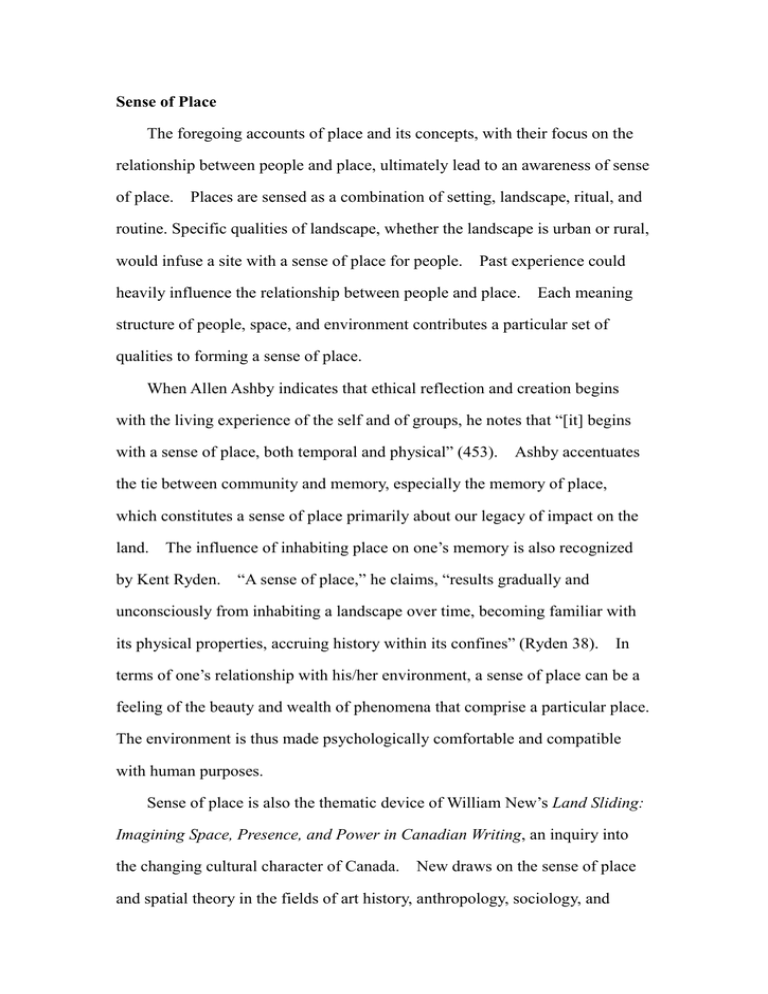Sense of Place
advertisement

Sense of Place The foregoing accounts of place and its concepts, with their focus on the relationship between people and place, ultimately lead to an awareness of sense of place. Places are sensed as a combination of setting, landscape, ritual, and routine. Specific qualities of landscape, whether the landscape is urban or rural, would infuse a site with a sense of place for people. Past experience could heavily influence the relationship between people and place. Each meaning structure of people, space, and environment contributes a particular set of qualities to forming a sense of place. When Allen Ashby indicates that ethical reflection and creation begins with the living experience of the self and of groups, he notes that “[it] begins with a sense of place, both temporal and physical” (453). Ashby accentuates the tie between community and memory, especially the memory of place, which constitutes a sense of place primarily about our legacy of impact on the land. The influence of inhabiting place on one’s memory is also recognized by Kent Ryden. “A sense of place,” he claims, “results gradually and unconsciously from inhabiting a landscape over time, becoming familiar with its physical properties, accruing history within its confines” (Ryden 38). In terms of one’s relationship with his/her environment, a sense of place can be a feeling of the beauty and wealth of phenomena that comprise a particular place. The environment is thus made psychologically comfortable and compatible with human purposes. Sense of place is also the thematic device of William New’s Land Sliding: Imagining Space, Presence, and Power in Canadian Writing, an inquiry into the changing cultural character of Canada. New draws on the sense of place and spatial theory in the fields of art history, anthropology, sociology, and geography, in addition to a diverse body of critical writing and insights from feminism, new historicism, and postcolonial studies. His general thesis can be summarized in a short statement: place can be text and text can also be place. Following recent critical insights in the theorization of space and place per se, New's study extends beyond the literary to the visual arts, encompassing familiar Canadian artists and artists working in less conventional media. New reads place and space as relational notions. For him, place designates a particular use of space, and space designates a set of assumptions governing a people's attitudes towards social practice—production, distance, and power. Based on Lefebvre’s concept of spatial production, he also emphasizes that the most general descriptions of social relationships are often spatial. He further argues that space can become a social commodity and that spatial metaphors can also be read for the power relationships they reveal. He demonstrates his reading of spatial metaphors in the construction, confirmation, and subversion of a culturally dominant representation of Canada. Since it is firmly associated with experience and memory, sense of place appears to be a fuzzy concept and very often purely subjective. Yet, as suggested in the concept of place previously discussed, sense of place can be the attribution of non-material characteristics to a place—the soul of a place or its genius loci. It can also be the force that defines a person by a given piece of land, making him/her emotionally and spiritually bound to the land. Moreover, sense of place is embodied in narratives related to family, community, and folk, which include features of place and constitutes an attachment to place. Intimate understandings of a place are best expressed by natives, even though it may be possible for an outsider to broadly describe the place. After all, a place is comprised not only of natural features, but also of patterns of human settlement and social relationships. Sense of place is thus determined by local knowledge and displayed by people congruent with local identity. The identification of places, as well as their organization into mental structures, not only allows people to function effectively but serves also as a source of emotional security, pleasure, and understanding. To be sure, the connection between people and place is a key component of sense of place. The connection between people and place is also an important aspect in the study of John Agnew, an eminent cultural geographer. In explaining his idea of place as a counter-representation of space, Agnew puts greater emphasis on sense of place than on location or locale. Against the common idea that senses of place derive from our contact with the physical realities of the locale and location we are in, he holds that a sense of place bears with it a “subjective territorial identity” (Agnew 262), which is a major requisite for understanding the order of location. Agnew thus combines the human subject with the place it is in, puts it in an interaction with its surroundings, and locates it at a position where meanings derive from the connection between body and place over time. The same idea is crystallized in Fredric Jameson’s statement: Disalienation in the traditional city, then, involves the practical reconquest of a sense of place and the construction or reconstruction of an articulated ensemble which can be retained in memory and which the individual subject can map and remap along the moments of mobile, alternative trajectories. (51) What is suggested here is that sense of place is linked to our experience with lived space rather than to any sense of abstract space. It is not used only to refer to spatial locations, but also to locate people inside society. All the important metaphors Jameson uses here—ensemble, map, and trajectories—are spatial vehicles for us to approach a better understanding of what sense of place can be. Based on all the preceding ideas and concepts, we can understand sense of place at least in terms of its nature and functions. First, sense of place produces spatial orientation. It produces in the human subject the capability of being oriented by its surrounding objects. When we lack a sense of place, we will be disoriented, lost in space. Second, sense of place enhances spatial mapping. It encompasses tacit knowledge of a place, enabling one to describe a part, find a route, or draw a map without needing either linguistic or visual memory. Third, sense of place creates spatial awareness. It can be understood as an ensemble of knowledge about a place, where there is neither an articulated system nor a systematic structure, and where a sense of the whole comes from knowledge about parts. Fourth, sense of place integrates our spatial experience into a mental model. Such a mental model helps us situate ourselves in a given place, and thereby produces our spatial relationship with the place. We carry it with us, transfer it to any other places, and employ it to decode whatever spatial messages that may come to us. It is noteworthy that these four aspects indicate that sense of place works in a way that is both metaphorical and metonymical: metaphorical in that it enables us to transfer our spatial experience with one place to our experience with another place, metonymical in that it enables us to imagine a space by certain spatial elements without awareness of its full picture. This is strongly suggested by Jameson in his statement quoted above. In order to regain a sense of place, which we have lost and may not have ever had, he resorts to such temporal elements as memories and experiences. Yet, rather than a historical record, he brings these elements together in a cognitive map, which situates us in a spatial relationship with our memories and experiences. When we are cognitively mapping our memories and experiences, we find ourselves able to understand them in a metaphorical way. In a cognitive map of our city, we are able to resituate ourselves in the city and consequently recognize ourselves as part of the city. As we move along the routes and meet the blocks and areas on the map, we are also mapped into a moving icon and integrated into the map. With the routes and blocks and areas, which represent not only streets and places in our city but also carry our memories and experiences of them, we can construct or reconstruct our relationship with the city. This is indeed an integration of temporal and spatial elements. Through it, a sense of place can possibly generate in us, with the help of metaphors and metonyms. Metaphor and metonymy, of course, are familiar concepts borrowed from linguistics. Such a conceptual borrowing is underwritten by careful examinations of the relationship between space and language that both Henry Lefebrve and George Lakoff have respectively practiced in philosophy and linguistics.



